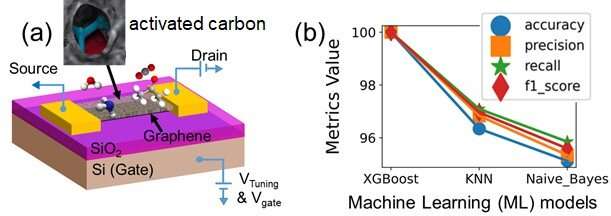This article has been reviewed according to Science X's editorial process and policies. Editors have highlighted the following attributes while ensuring the content's credibility:
fact-checked
proofread
New machine-learning approach identifies one molecule in a billion selectively, with graphene sensors

Graphene's 2D nature, single molecule sensitivity, low noise, and high carrier concentration have generated a lot of interest in its application in gas sensors. However, due to its inherent non-selectivity, and huge p-doping in atmospheric air, its applications in gas sensing are often limited to controlled environments such as nitrogen, dry air, or synthetic humid air.
While humidity conditions in synthetic air could be used to achieve controlled hole doping of the graphene channel, this does not adequately mirror the situation in atmospheric air. Moreover, atmospheric air contains several gases with concentrations similar to or larger than the analytic gas. Such shortcomings of graphene-based sensors hinder selective gas detection and molecular species identification in atmospheric air, which is required for applications in environmental monitoring, and non-invasive medical diagnosis of ailments.
The research team led by Dr. Manoharan Muruganathan (formerly Senior Lecturer), and Professor Hiroshi Mizuta at the Japan Advanced Institute of Science and Technology (JAIST) employed the machine learning (ML) models trained on various gas adsorption-induced doping and scattering signals to realize both highly sensitive and selective gas sensing with a single device.
The ML models' performances are often dependent on the input features. 'The conventional graphene-based ML models are limited in their input features', says Dr. Osazuwa Gabriel Agbonlahor (formerly post-doctoral research fellow). The existing ML models only monitor the gas adsorption-induced changes in the graphene transfer characteristics or resistance/conductivity without modulating these characteristics by applying an external electric field.
Hence, they miss distinctive van der Waals (vdW) interaction between gas molecules and graphene, which is unique to individual gas molecules. Hence, unlike the conventional electronic nose (e-nose) models, we can map the external electric field modulated graphene-gas interaction, which enables more selective feature extraction for complex gas environments such as atmospheric air.
Our ML models for the identification of atmospheric gases were developed using the graphene sensor functionalized with a porous activated carbon thin film. Eight vdW complex features were used to monitor the effects of the external electric field on the graphene-gas molecule vdW interaction, and consequently mapped the evolution of the vdW bonding before, during, and after the external electric field application.
Furthermore, although the gas sensing experiments were performed under different experimental conditions e.g., gas chamber pressures, gas concentrations, ambient temperature, atmospheric relative humidity, tuning time, and tuning voltage, the developed models were shown to be robust enough to accommodate these variations in experimental conditions by not exposing the models to these parameters.
Moreover, to test the models versatility, they were trained on atmospheric environments as well as relatively inert environments that are often used in gas sensing e.g., nitrogen and dry air. Hence, a high-performance atmospheric gas "electronic nose" was achieved, distinguishing between the four different environments (ammonia in atmospheric air, acetone in atmospheric air, acetone in nitrogen, and ammonia in dry air) with 100% accuracy.
The research is published in the journal Sensors and Actuators B: Chemical.
More information: Osazuwa G. Agbonlahor et al, Machine learning identification of atmospheric gases by mapping the graphene-molecule van der waals complex bonding evolution, Sensors and Actuators B: Chemical (2023). DOI: 10.1016/j.snb.2023.133383
Provided by Japan Advanced Institute of Science and Technology



















